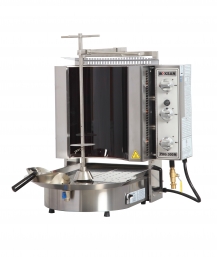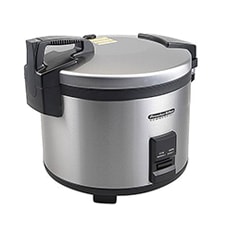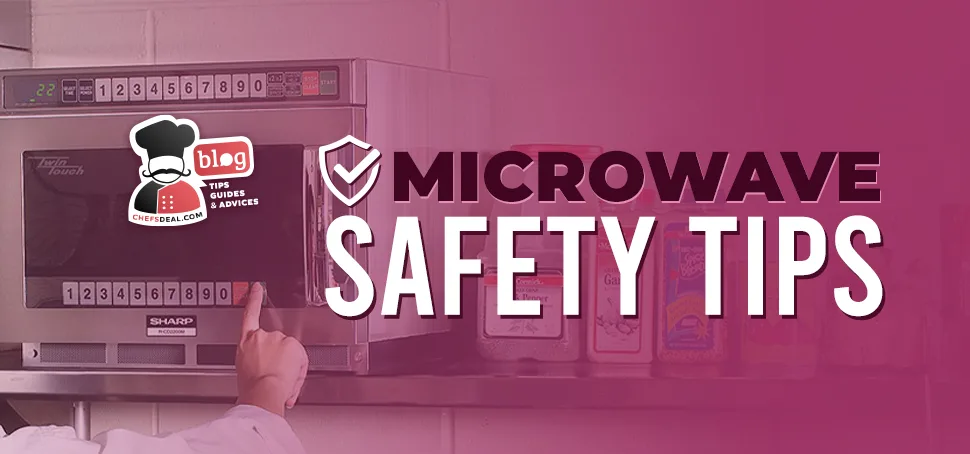Restaurant cooking equipment is the keystone of any commercial kitchen. These hard workers of your kitchen will take on most of the work, so the equipment should be chosen carefully to run your business efficiently. With various options like countertop & under-counter, gas&electric or half&full sized, you need to decide depending on your needs. Each tool has features that set it apart, but the common point is to cook food. And knowing which restaurant cooking equipment to use properly is the point to do it in the best way possible. Here is our ultimate cooking list to help you:
Commercial Ovens
The commercial oven is the main piece of commercial restaurant cooking equipment. You should choose the type of commercial oven, considering your capacity and food type. Your available space and the amount of food you’ll serve will determine the size and the kind of oven.

Commercial Convection Ovens: A commercial convection oven uses fans to circulate hot air throughout the oven. These fans reduce shrinkage and cooking time which saves you money and time in the long term. And with consistent heat, food cooks evenly.
Combination Ovens: The combination oven combines the functions of a convection oven and a commercial steamer. The main advantage of this type of commercial oven is its flexibility. You can roast, steam, smoke, fry, bake, or grill using a combination oven, which means it can perform the functions of different cookers in a single tool.
Commercial Conveyor Ovens: Almost anything you cook in a standard oven can be cooked in a conveyor oven. It cooks food by passing it on a conveyor belt. With consistent speed and heat, food cooks evenly. Just place the food on the belt; you do not need to do anything more.

Commercial Deck Ovens: The point that sets it apart from convection ovens is how they transfer the heat. Commercial deck ovens use a heated stone shelve or heated air for baking and cooking food. They also use radiant heat and hold the heat well. They are usually used for making bread and pastry.
Commercial Steam Ovens: Steam is a healthy way of cooking. It’s generally used for seafood, vegetables, rice, and more. Steam ovens cook fast while keeping the vitamin and minerals of food inside by using steam for cooking. Steam oven reduces the flavor transfer, which means you can cook different dishes at the same time.
Commercial Microwave Ovens: Commercial microwave ovens offer quick cooking and warming process in a short period, and since they do not require a ventilation hood, these restaurant cooking equipment is highly flexible. Depending on your business volume, there are three options to choose from: light, medium, and heavy-duty microwaves.
Rotary Ovens: The airflow system they have cooks any product wholly and evenly, making it one of the most required restaurant cooking equipment. The rotator stops during loading or unloading the food items and starts rotating as the door closes. The steam control offers a stable heat and moisture distribution, achieving perfect results.
Commercial Ranges

As an essential piece of restaurant cooking equipment, a range can be used to steam, simmer, boil, fry, or grill foods. While purchasing a commercial range, you should consider your available space and power sources since there are gas or electric options. Some of them come with an oven, which lets you bake food as well.
Commercial Gas Ranges: You can completely control the temperature with a commercial gas range that offers better cooking. Starting immediate heat, gas ranges offer shorter cooking times. They require some additional equipment and tools, which may cause an extra cost. But you can use them even during a power outage.
Commercial Electric Ranges: Commercial electric ranges are easier and cheaper to install compared to commercial gas ranges. They are efficient, cooks evenly, and are easy to clean. Plus, you will not have the risk of fire or gas leaks.

Cook and Hold Ovens: Cook and hold ovens cook food slowly, reducing shrinkage and keeping the food at safe and warm temperatures for hours after it is cooked. They are perfect for meat, giving tender results. Once the temperature has reached or the timer has ended, it switches to holding mode so that you won’t worry about the cooking time anymore while keeping food warm and ready to serve at the same time.
Commercial Induction Range: Commercial induction ranges have ceramic cooktops, and the heat is produced only in the base part, making it safer than other types. They use electric currents to heat the cookware through magnetism. With the speed of heat, it will save you a significant amount of time.
Commercial Hot Plate: They will come in handy for the establishments that do not have enough space for a full range. The gas types heat up more quickly and adapt to temperature changes more easily. However, they are harder to install. The electric hot plates are pretty cheaper and do not require additional installation steps. Hot plates are generally smaller than induction ranges in size while being a bit heavier.
Commercial Grill and Griddles

A commercial grill with a griddle is another restaurant cooking equipment that can cook multiple food items. The flat surface heats up quickly, ideal for cooking pancakes, bacon, eggs, and sausages. There are various types, such as countertop or free-standing and gas or electric grills. Commercial electric grills are perfect restaurant cooking equipment for kitchens without gas utility, while gas grills are very energy-efficient. Space could be the most decisive point while purchasing a commercial grill.
Teppanyaki Griddles: These restaurant cooking equipment are designed to fit into a countertop to make it at the same level as the table. The central part of the completely flat hob is the most heated. The middle part is where the food is cooked, while the near sides are used for warming. You can cook vegetables, seafood, chicken, and noodles in Japanese style with a teppanyaki griddle.
Charbroilers: The primary function of a charbroiler is the smoky flavor and markings it gives to meat, vegetables, and seafood. You can choose between different materials, fuel sources, and heating options such as lava rocks, radiant, or ceramic bricks.
Commercial Fryers
A commercial deep fryer is used for frying a huge amount of food. There are different commercial deep fryer types, and you can choose one depending on the kind of food you serve. The common point is to heat the oil to a certain temperature, cook the food in the basket, then drain the oil when the food is ready.

Donut Fryers: Unlike standard fryers, donuts and funnel cakes require large, shallow pans to prevent fragmentation during the cooking process.
Ventless Countertop Fryer: Proper ventilation is typically needed for various kitchen appliances, which may demand space that you may not have readily accessible. Each ventless fryer model includes cutting-edge filtration technology that eliminates the need for hood ventilation, which can help to reduce that load. This means you can use it anywhere, even without a hood vent.
Greaseless Fryer: A greaseless fryer does the same job as a deep fryer, reducing the calories with no use of fat. They cook with hot air blowing around. The best part of them is that they cook faster than a conventional oven and do not use oil, making it healthier and easy to clean, unlike a deep fryer.
Commercial Toasters
A commercial toaster is a long-term needed restaurant cooking equipment, so using the right type will extend the lifetime. For small businesses with low production, a pop-up toaster will do the job. You can choose the brownness level, and it will toast up to 380 slices per hour. It is perfect for muffins, bread, and bagels. Conveyor toasters are ideal for high-volume establishments. They work with a conveyor belt where you put bread, muffin, bagels, and more, and they pass through a heated section. They are in various sizes with a range of 200 to 1800 slices per hour.
Commercial Steamers

Cooking with a commercial steamer is a very healthy and beneficial way. Steam cooks food quickly without drying them, which preserves its color, vitamins, and minerals. And another reason for being healthy is there is no use of fat or oil.
Pressure Steamer: Generally, high-volume businesses use pressure steamers because of it’s cooking speed. The pressure lets the interior temperature rise to 250 degrees Fahrenheit.
Convection Steamer: A convection steamer cooks without pressure at 212 degrees Fahrenheit. Because of lower cooking temperatures, they offer higher quality outcomes. They are generally more preferred because of their lower prices.
Steam Kettles
To heat soups, sauces or pasta quickly and easily, a commercial steam kettle is what you are looking for. Working similar to a pot, but you can warm the food with more control. The steam heats evenly surrounding the exterior of the chamber where the food cooks. Commercial kettles offer fast cooking times and less burning.

Commercial Broilers
A commercial broiler is a restaurant cooking equipment that cooks food using radiant heat, adds finishing to already cooked food, or melts the cheese.
Salamander Broilers
A salamander broiler uses infrared broilers to cook various food, melt cheese, or add a perfect ending touch to any dish. The point that makes it better than other broilers is that when the ceramic is heated, it retains hot while on standby, removing the need to re-heat.
Rotisserie Broilers
A rotisserie broiler is a restaurant cooking equipment that uses rotating skewers to cook food. With the glass doors, it is used as a displaying merchandiser as well. They can cook a variety of foods, but they are mainly used for chickens. They use radiant and convection heat; while one browns the meat, the other roasts it.
Commercial Cheesemelters
Commercial cheese melters are a perfect piece of restaurant cooking equipment for finishing touches. While you can cook food with a salamander broiler, a commercial cheese melter can not do it. They give the final browning to already cooked dishes, melt cheese, or toast bread.

Vertical Broilers
Also known as gyro machines, vertical broilers are used for cooking meat to make kebabs, shwarma, or doners from shaved meat. A vertical spit rotates the meat while the radiant heat from a gas or electric burner cooks. This slow roasting keeps the meat moist, offering delicious outcomes.
Specialty Cooking Equipment

To properly prepare unique food products, you need the equipment specifically designed for them. From pasta rethermalizes to rice cookers, the required restaurant cooking equipment will provide perfect servings.
Commercial Pasta Cookers
A commercial pasta cooker is perfect for any food business that has pasta on its menu. İt quickly boils water and cooks pasta, and the pasta baskets remove pasta from boiling water safely.

Commercial Rice Cookers
A commercial rice cooker can hold the rice warm, as well as cooking it. Some of them automatically switch to keeping warm after the rice is cooked. A rice cooker has a separate bowl and a movable lid for easy cleaning. With fast cooking time and the feature of keeping warm, it is what a food operation with rice on its menu needs.
Waffle Makers
There are three types of waffle machines; Belgian waffle makers, waffle cone makers, and bubble waffle makers. No matter the type, they all come in grid plates made from heat-holding materials. Choosing a non-stick material waffle maker will remove the need for fat or sprays.

Tortilla Machines
For a restaurant serving tortillas, a tortilla machine is essential to make perfectly flat and fresh tortillas. With practical handles, it is too easy to press tortillas with a bit of force. And a tortilla warmer grill will bake or heat the tortillas properly for serving.
Cooking Equipment Parts and Accessories
Typically, the first and right thing to do is to call the service center when there is a problem. But also, to have the little parts that you can stock up on for minor changes that you can make yourself is important for the restaurant cooking equipment to continue working flawlessly.
Conclusion
Cooking is the main part of any food service business. Every restaurant is unique, with distinct requirements based on the type of cuisine and client it targets. When looking for restaurant cooking equipment to start as a restaurant owner or manager, keep your specific needs and objectives in mind. Do not forget; it’s all about selecting the proper restaurant cooking equipment for you and your business.






1 comments On Essential Restaurant Cooking Equipment: The Ultimate List
Pingback: Buying Catering Equipment: 7 Types You Need – Chef’s Deal ()